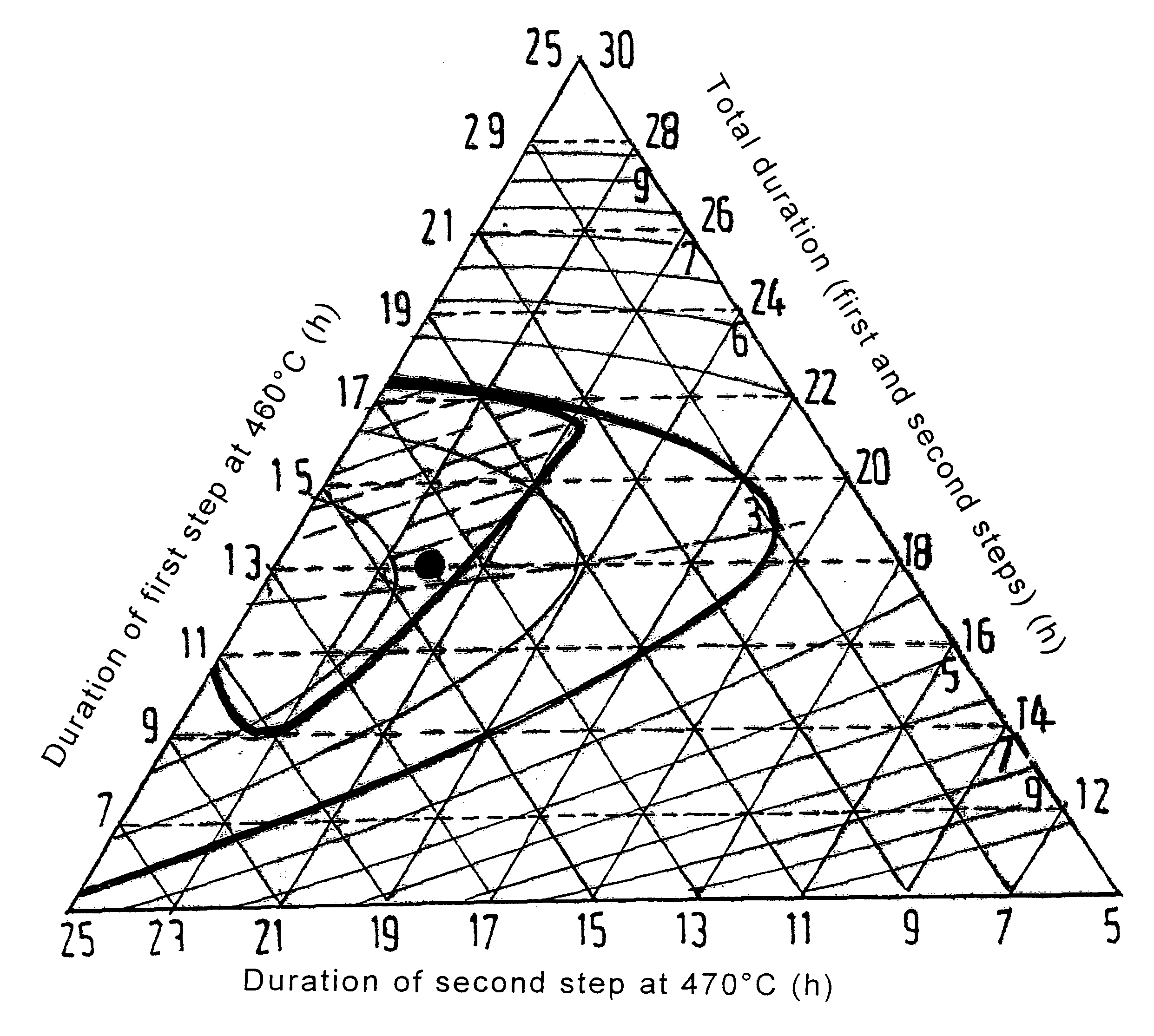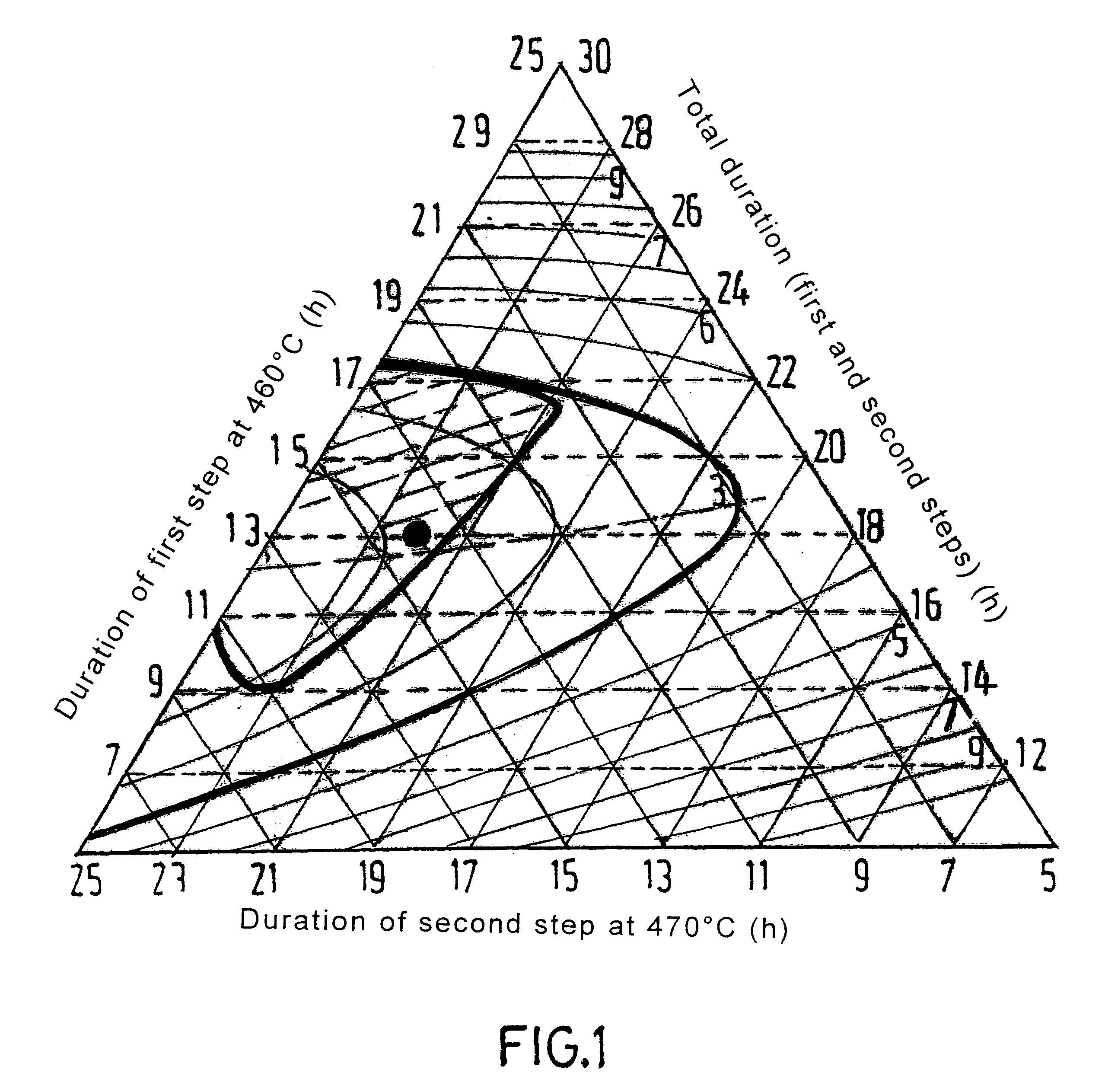Manufacturing process for a hollow pressure vessel made of AlZnMgCu alloy
- Summary
- Abstract
- Description
- Claims
- Application Information
AI Technical Summary
Benefits of technology
Problems solved by technology
Method used
Image
Examples
example 1
Influence of Homogenization
Billets were cast made of 7060 alloy with the following composition (% by weight):
Si=0.02, Fe0.04, Cu=2.07, Zn=6.92, Mg=1.76, Cr=0.20.
These billets were homogenized in two steps with a first step at 460 or 465.degree. C. and a second step at 470.degree. C., by varying the duration of each of the steps according to a predetermined experience plan. For each homogenization treatment, a micrographic examination was made to evaluate fragmentation and resorption of the copper phases at 4 mm from the edge of the billet. Micrographies were classified according to a qualitative index from 1 (very good) to 7 (bad). Table 1 gives the various homogenization treatments and the corresponding qualitative index.
The results were validated by image analysis and led to a recommended area represented in a triangular diagram shown in FIG. 1, the coordinates of which are the time of the first step at 460.degree. C., the time of the second step at 470.degree. C., and the total t...
example 2
Influence of Softening
Billets made from the same alloy as in the previous example were homogenized according to the defined set value for 13 h at 460.degree. C.+14 h at 470.degree. C. After returning to ambient temperature, the hardness is greater than 70 HB. This hardness is not stable and increases with time. In order to soften the billet before extrusion, an annealing treatment was applied with a 3 h step at 400.degree. C., a 6 h step at 300.degree. C., a 6 h step at 230.degree. C., and cooling at a rate of 20.degree. C. / h until the metal temperature drops below 100.degree. C. The hardness of the billet after reaching ambient temperature is 52 HB, and this does not change with time. This invariance in the hardness with time indicates that the softening treatment is efficient.
example 3
Influence of Aging
153 mm diameter billets were cast with the following composition (% by weight):
Si=0.02, Fe=0.040, Cu=2.06, Mg=1.67, Zn=7.14, Cr=0.20.
These billets were homogenized by a two-step treatment for 13 h at 460.degree. C. and 14 h at 470.degree. C. They were then softened by the treatment described in the previous example and then cut into 3.35 kg slugs to be cold extruded to form a casing which, after the neck has been drawn and tapered, is transformed into a cylinder body to contain compressed or liquefied gases with a capacity of 3 l, outside diameter 117 mm, length 432 mm, and designed to resist a test pressure of 205 MPa after heat treatment.
These cylinders were solution heat treated by a 2 h treatment at 475.degree. C. The solution treatment quality of the entire cylinder was evaluated by differential enthalpic analysis using a Perkin-Elmer DSC7 instrument with a temperature rise rate of 20.degree. C. / min. Samples were taken on the outside and inside of the cylinder...
PUM
| Property | Measurement | Unit |
|---|---|---|
| Temperature | aaaaa | aaaaa |
| Temperature | aaaaa | aaaaa |
| Temperature | aaaaa | aaaaa |
Abstract
Description
Claims
Application Information
 Login to View More
Login to View More - R&D
- Intellectual Property
- Life Sciences
- Materials
- Tech Scout
- Unparalleled Data Quality
- Higher Quality Content
- 60% Fewer Hallucinations
Browse by: Latest US Patents, China's latest patents, Technical Efficacy Thesaurus, Application Domain, Technology Topic, Popular Technical Reports.
© 2025 PatSnap. All rights reserved.Legal|Privacy policy|Modern Slavery Act Transparency Statement|Sitemap|About US| Contact US: help@patsnap.com


